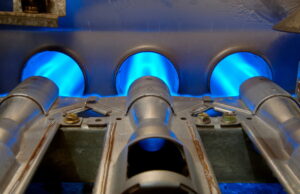
We’re going to get into some serious business here when it comes to furnace repair in Conyers, GA. We always take our business as HVAC technicians seriously because it makes a huge difference in the lives of our customers. But safety is a special concern we have, and we want to see that our customers are able to enjoy the warmth from their gas furnaces during the winter without the worry about leaks of toxic combustion gases.
First: Gas Furnaces Are Not Automatically Dangerous
We want all our readers to know this upfront: there is nothing inherently dangerous about having a gas furnace in your house. Natural gas furnaces are the most common central heating systems in the country, and if they were risky appliances to have around, they would not be allowed in homes at all. Manufacturers of gas furnaces design them with safety uppermost in mind, and our technicians are trained to work on furnaces to keep them running at their safest.
Now … About That Cracked Heat Exchanger
We hope we’ve set your mind at ease about running your gas furnace. Now we have to talk about one of the potential hazards you may run into so you can avoid it. It’s the cracked heat exchanger.
What Is a Heat Exchanger?
It’s the metal container inside a furnace where hot combustion gas collects. The gas heats up the metal of the exchanger so it warms the air sent through the furnace and into the ventilation system. This is how the furnace heats the air without allowing the combustion gases and exhaust vapors to come into contact with it. When the heating cycle is finished, the combustion gas is sent out a flue to safely exit the house.
The Danger of Cracks in the Heat Exchanger
If the metal of the heat exchanger develops cracks, they can spread open as the metal expands with the heat. This will allow the combustion gases in the exchanger to escape and enter the air that’s sent into the house—a dangerous situation since carbon monoxide is one of the main gases.
What Can Be Done to Prevent This?
The best defense against a cracked heat exchanger is to make sure the furnace is maintained professionally each fall. Maintenance helps to fend off the causes of cracks developing, such as moisture and poor ventilation that can lead to corrosion along the metal of the exchanger. Maintenance also includes safety inspections that examine the heat exchanger for any signs of corrosion, weakening metal, or the start of cracks.
Can a Cracked Heat Exchanger Be Repaired?
The best way to fix a cracked heat exchanger is to replace the entire exchanger. Once cracks start to appear, the entire exchanger is at higher risk. However, because cracks usually appear in a furnace that is extremely old, it’s often a better choice to have a new furnace installed rather than spend money on a new exchanger. If you work with our team, we’ll give you honest answers about the best next steps to take when you have a furnace that needs a major repair like this.
Experience the Premier Difference! Premier Heating & Air has been family-owned and operated since 2001.

